前交叉韧带重建的移植物选择
交叉韧带重建手术和植入物简述

6
A CL 股 骨 止 点 的 骨 性 解 剖 标 志
髁间窝外侧分叉嵴
髁间窝外侧嵴
髁间窝外侧嵴(住院医师嵴)
• 屈膝 90 ° 时,住院医师嵴走行于髁间窝 外侧壁 ,
AC L在住院医师嵴下方而非髁间 窝的 顶 部 。
观察外侧嵴与分叉嵴
髁间窝 外侧分叉嵴
需将残端清除
• 髁间窝外侧分叉嵴垂直于住 院 医 师嵴 ,并在其下方,
解剖重建
前 后
前 后
优势 :
优势 :
• 减少牵拉导致的“雨刷效应”和骨隧 道 扩大效应以及重建韧带的慢性松弛 ;
• 手术操作相对简便 ; 不依赖韧带周围特 有解剖标志,骨隧道位置比较恒定 。
• 恢复了 AC L 的原始解剖位置,更符 合其在体内的生物力学特性, 恢复膝 关节的前后稳定性 & 旋转稳定性 。
01
交叉韧带重建概览
膝关节交叉韧带走行
交叉韧带:髁间窝内两条前后交错的韧带,也称十字韧带 • 前交叉韧带(Anterior Cruciate Ligament , 简称ACL): 后外向前内走行 • 后交叉韧带(Posterior Cruciate Ligament , 简称PCL):前内向后外走行
• 减少术后骨性关节炎的 发生;
不足 :
不足 :
• 可有效控制膝关节前后稳定性,但对 于
• 股骨骨 隧道有过短风险;
15
膝关节旋转稳定性控制效果欠佳 。
• 股骨 后壁有爆裂 的风险。
单 束 重 建 VS 双 束 重 建 单束重建
VS
双束重建
• 临床解剖研究: 双束重建具有更好的稳定性, 更接近ACL解剖;
• A CL 胫 骨 止 点 为 椭 圆 形 , 分 为 AM (蓝色 )和 PL (红色 ) • AM 束胫骨 止点: 位于胫骨平台 前内侧面 ,其中间缘在
关节镜下3种移植物重建膝关节前交叉韧带的临床效果
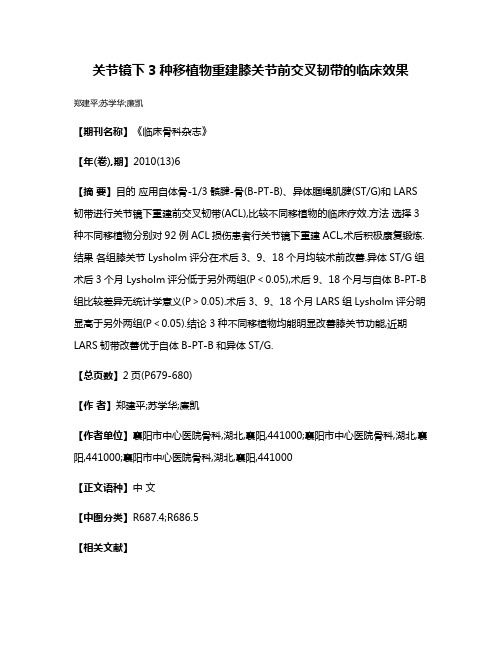
关节镜下3种移植物重建膝关节前交叉韧带的临床效果郑建平;苏学华;廉凯【期刊名称】《临床骨科杂志》【年(卷),期】2010(13)6【摘要】目的应用自体骨-1/3髌腱-骨(B-PT-B)、异体腘绳肌腱(ST/G)和LARS 韧带进行关节镜下重建前交叉韧带(ACL),比较不同移植物的临床疗效.方法选择3种不同移植物分别对92例ACL损伤患者行关节镜下重建ACL,术后积极康复锻炼.结果各组膝关节Lysholm评分在术后3、9、18个月均较术前改善.异体ST/G组术后3个月Lysholm评分低于另外两组(P<0.05),术后9、18个月与自体B-PT-B 组比较差异无统计学意义(P>0.05).术后3、9、18个月LARS组Lysholm评分明显高于另外两组(P<0.05).结论 3种不同移植物均能明显改善膝关节功能,近期LARS韧带改善优于自体B-PT-B和异体ST/G.【总页数】2页(P679-680)【作者】郑建平;苏学华;廉凯【作者单位】襄阳市中心医院骨科,湖北,襄阳,441000;襄阳市中心医院骨科,湖北,襄阳,441000;襄阳市中心医院骨科,湖北,襄阳,441000【正文语种】中文【中图分类】R687.4;R686.5【相关文献】1.关节镜下膝关节前交叉韧带重建移植物的选择及康复护理进展 [J], 朱素芹2.关节镜下4种移植物重建膝关节前交叉韧带的临床效果研究 [J], 温鹏;万钧;杨晓宇;牛东生;任磊;郝斌;罗小军;王庆锋3.三种移植物关节镜下重建膝关节前交叉韧带效果比较:2年随访 [J], 王昆;朱蕾;曾春;卢华定;蔡道章4.关节镜下不同种类移植物对膝关节前交叉韧带重建的临床效果观察 [J], 杨志发;刘展亮;李晓彬;杨永迁5.不同时机膝关节镜下前交叉韧带重建术治疗前交叉韧带损伤临床效果比较 [J], 万宏来因版权原因,仅展示原文概要,查看原文内容请购买。
关节镜下3种移植物重建膝关节前交叉韧带的临床效果
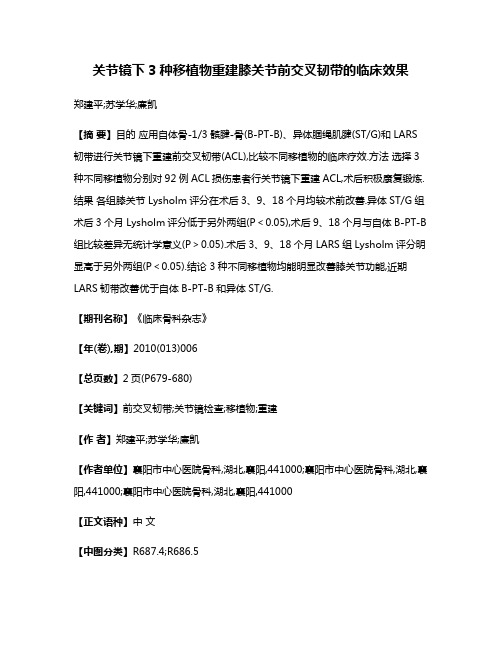
关节镜下3种移植物重建膝关节前交叉韧带的临床效果郑建平;苏学华;廉凯【摘要】目的应用自体骨-1/3髌腱-骨(B-PT-B)、异体腘绳肌腱(ST/G)和LARS 韧带进行关节镜下重建前交叉韧带(ACL),比较不同移植物的临床疗效.方法选择3种不同移植物分别对92例ACL损伤患者行关节镜下重建ACL,术后积极康复锻炼.结果各组膝关节Lysholm评分在术后3、9、18个月均较术前改善.异体ST/G组术后3个月Lysholm评分低于另外两组(P<0.05),术后9、18个月与自体B-PT-B 组比较差异无统计学意义(P>0.05).术后3、9、18个月LARS组Lysholm评分明显高于另外两组(P<0.05).结论 3种不同移植物均能明显改善膝关节功能,近期LARS韧带改善优于自体B-PT-B和异体ST/G.【期刊名称】《临床骨科杂志》【年(卷),期】2010(013)006【总页数】2页(P679-680)【关键词】前交叉韧带;关节镜检查;移植物;重建【作者】郑建平;苏学华;廉凯【作者单位】襄阳市中心医院骨科,湖北,襄阳,441000;襄阳市中心医院骨科,湖北,襄阳,441000;襄阳市中心医院骨科,湖北,襄阳,441000【正文语种】中文【中图分类】R687.4;R686.52003年2月~2009年6月,我院对 92例单纯前交叉韧带(ACL)损伤患者分别应用自体骨 -1/3髌腱 -骨(B-PT-B)、异体腘绳肌腱(ST/G)和LARS(ligamentadvanced reinforcementsystem)韧带进行关节镜下 ACL重建,并经随访,笔者对术前术后情况进行分析。
1 材料与方法1.1 病例资料1.1.1 自体 B-PT-B组 27例,男 19例,女 8例,年龄 16~55(41.93±0.25)岁。
左膝9例,右膝 18例。
运动伤 17例,生活中损伤 10例。
受伤至手术时间为1~78(9.43±0.34)个月。
交叉韧带重建移植物的选择

髌骨关节炎、膝前疼痛、 髌腱断裂等。 ❖ 多一切口,外观稍差。
优点 ❖ 取材快捷,可重复取材 ❖ 可根据需要随意取材 ❖ 缩短手术时间,创伤更少 ❖ 无自体取材后的并发症 缺点 ❖ 有传播疾病及排斥反应可能 ❖ 费用较多 ❖ 康复时间稍长
精选ppt
术前处理
常规检查 血常规 生化 肝肾功能 特殊检查 免疫八项 血沉 术前谈话与签字
必须告之同种异体移植物年存在传播疾病的可 能性。介绍自体与同种异体移植物的优缺点,由患 者选择。
精选ppt
15
术后处理
1. 观察全身及局部反应、免疫指标、关节功能。 2. 一般处理与自体移植物重建术后相同 3. 特殊处理
(小胶原纤维及受体成纤维细胞)
精选ppt
17
精选ppt
18
精选ppt
19
同种异体材料
异体髌骨—髌腱—胫骨或跟腱—跟骨:
优点: 1、同自体材料相同的抗拉强强度; 2、移植物两端与隧道周围骨组织为骨性愈合, 结合牢固; 3、该方法不存在供区并发症及自体组织缺失; 4、可多次取材,可根据患者具体情况切取更为 理想的移植物。
精选ppt
13
消毒
环氧乙烷 引起术后持续性滑膜炎,关节囊变性。现已弃用。
伽马射线 通过改变病毒DNA引起病毒死亡
3 Mrad射线— 完全破坏HIV,但移植物张力及负荷减少 1.5~2.5 Mrad射线— 保持移植物张力及负荷
但不能完全破坏HIV遗传物质
深低温冷冻法:是目前主要的使用方法
精选ppt
14
建后生物力学强度要失去原强度的50%。
2. 良好的生物相容性:不存在免疫排斥,不对受
前交叉韧带重建手术要点

前交叉韧带重建手术要点学习前交叉韧带重建手术这么久了,今天来说说关键要点。
首先呢,患者的术前评估很重要。
这就好比盖房子之前得先好好看看地基咋样。
要评估患者的受伤机制、膝关节的稳定性、活动度之类的。
我理解这一步是为了全面了解患者的情况,这样才能制定出最适合的手术方案。
比如说一个运动员和一个普通上班族受伤,可能在方案选择上就得有些差别。
我以前就困惑为啥要这么详细地问受伤当时的情境,后来才明白不同的受伤机制对韧带损伤的程度和范围影响很大。
学习的时候我总结了个小技巧,把患者想象成一个精密的仪器,每个细节都可能影响最后的维修效果,所以术前评估一定要细致全面。
在手术过程中呢,隧道定位可是要点中的要点。
这就像是导航一样,要是定错了位,后面就全乱套了。
我记得我当时学着理解这个的时候特别头疼,那些什么股骨隧道、胫骨隧道的解剖位置老记混。
后来我就拿家里的椅子腿和桌子腿来类比,想象在上面钻洞来固定东西,这样就好记多了。
对了还有个要点,移植物的选择也很关键。
常见的有自体肌腱、同种异体肌腱等。
我理解选自体肌腱就像是用自己的零件来修自己的东西,可能更匹配,但是也得看患者自身肌腱的质量等等情况。
就像家里修东西,要是自己有合适的材料肯定优先用自己的。
同种异体肌腱则像是从别人那拿来合适的材料来修补,这就得多考虑兼容性。
术后康复也是不能忽视的部分。
这就好比汽车修好了,还得慢慢磨合。
康复计划得个性化定制,根据患者的手术情况、身体状况来调整。
我在学习中发现很多时候康复没做好,会影响手术最终的效果。
我总结了一点,就是要从患者的角度出发,多考虑患者的在康复过程中可能遇到的困难。
比如有的患者年纪大恢复慢,或者有的患者依从性不好,得想办法让他们按照计划来康复。
但我也知道我理解的还很有限,还需要继续学习很多知识呢。
我参考过的资料有很多医学的专业书籍,像《坎贝尔骨科手术学》,还有一些国内外的医学杂志文章,上面都有很多实用的信息。
总之这个前交叉韧带重建手术的要点还有很多,我也要不断去学习和探索。
前十字韧带撕裂怎么治疗
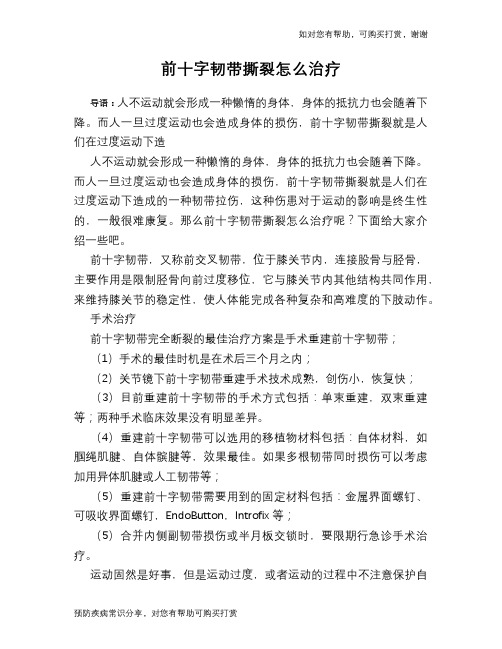
如对您有帮助,可购买打赏,谢谢
前十字韧带撕裂怎么治疗
导语:人不运动就会形成一种懒惰的身体,身体的抵抗力也会随着下降。
而人一旦过度运动也会造成身体的损伤,前十字韧带撕裂就是人们在过度运动下造
人不运动就会形成一种懒惰的身体,身体的抵抗力也会随着下降。
而人一旦过度运动也会造成身体的损伤,前十字韧带撕裂就是人们在过度运动下造成的一种韧带拉伤,这种伤患对于运动的影响是终生性的,一般很难康复。
那么前十字韧带撕裂怎么治疗呢?下面给大家介绍一些吧。
前十字韧带,又称前交叉韧带,位于膝关节内,连接股骨与胫骨,主要作用是限制胫骨向前过度移位,它与膝关节内其他结构共同作用,来维持膝关节的稳定性,使人体能完成各种复杂和高难度的下肢动作。
手术治疗
前十字韧带完全断裂的最佳治疗方案是手术重建前十字韧带;
(1)手术的最佳时机是在术后三个月之内;
(2)关节镜下前十字韧带重建手术技术成熟,创伤小,恢复快;
(3)目前重建前十字韧带的手术方式包括:单束重建,双束重建等;两种手术临床效果没有明显差异。
(4)重建前十字韧带可以选用的移植物材料包括:自体材料,如腘绳肌腱、自体髌腱等,效果最佳。
如果多根韧带同时损伤可以考虑加用异体肌腱或人工韧带等;
(5)重建前十字韧带需要用到的固定材料包括:金属界面螺钉、可吸收界面螺钉,EndoButton,Introfix等;
(5)合并内侧副韧带损伤或半月板交锁时,要限期行急诊手术治疗。
预防疾病常识分享,对您有帮助可购买打赏。
移植物类型对前交叉韧带重建后患者膝关节功能的影响

移植物类型对前交叉韧带重建后患者膝关节功能的影响李露祎;厉晓杰;黑泽明;刘华【期刊名称】《中国组织工程研究》【年(卷),期】2024(28)17【摘要】背景:临床上常采用移植物重建前交叉韧带,而不同移植物类型又影响着患者术后膝关节功能和康复方案的制定。
目的:回顾分析不同移植物类型对前交叉韧带重建后患者肌力、关节稳定性、功能性活动及重返运动的影响。
方法:在PubMed、Web of Science、Cochrane、中国知网、万方数据库中进行检索,中文检索词为“前交叉韧带重建术,自体移植物,同种异体移植物,人工韧带,骨-髌腱-骨,股四头肌肌腱,腘绳肌肌腱,腓骨长肌肌腱,康复训练,重返运动”;英文检索词为“anterior cruciate ligament reconstruction,autografts,allografts,artificial ligaments,bone-patellatendon-bone,quadriceps tendonautograft,hamstring tendon autograft,peroneus longus tendon autograft,rehabilitation,exercise,protocol,return to sport”。
结果与结论:选用骨-髌腱-骨移植物的患者应加强股四头肌离心收缩练习,康复后期应关注股四头肌耐力和爆发力的恢复。
与骨-髌腱-骨移植物和腘绳肌肌腱移植物相比,选用股四头肌肌腱移植物的患者在5-8个月内符合回归标准的患者明显更少,应制定较长时间的训练计划,训练周期尽量持续到3年以上。
选用腘绳肌肌腱移植物应强化多角度下腘绳肌力量训练,尤其是屈膝60°以上的周期至少持续至术后18周。
选用腓骨长肌肌腱移植物的患者后续应加强踝关节周围肌肉力量,以足底肌肉力量为主。
选用同种异体移植物应注意移植物经低剂量辐射消毒后其抗张力性降低20%,因此应关注膝关节稳定性训练。
关节镜下自体肌腱移植重建前交叉韧带讲义

解剖和生物力学
ACL起于胫骨髁间隆起 的前方,斜向后上外方, 附于股骨外侧髁的内侧 面。ACL长度37-41mm, 宽度10-12mm。 一般认为,ACL有两束, 分别为前内侧(AM)束和后 外侧(PL)束。
两束的解剖学分界取决 于膝关节屈曲一伸展时 ACL总的张力模式。 膝关节屈曲时AM束为 拉紧状态,伸展时PL束 为拉紧状态。 AM束限制膝关节的 前后移动,而PL束限制 膝关节的旋转运动。
BPB由于具有良好的生物力学特性,两端骨块 在骨隧道内可形成可靠的骨-骨愈合界面,长 期随访显示了良好的效果,从而被广泛使用。 所以,BPB曾被认为是ACL自体移植物的“金 标准”。
BPB重建ACL的缺点和并发症:骨块通过胫 骨隧道后口和和后关节腔拐弯处再进入股骨隧 道时比较困难。术后易于并发髌股关节骨关节 炎,髌腱挛缩,脂肪垫纤维化,髌骨骨折,髌 前跪行疼痛,韧带损伤;供区病变造成伸膝装 置损伤,髌前疼痛,此外手术切口位于膝前活 动区且切口较大。影响青少年骨骺发育等问题。 因此一些学者越来越推崇采用股四头肌腱和 四股腘绳肌腱等作为移植的材料。
2 腘绳肌腱移植的优缺点:目 前临床上四股HT的应用最为普 遍,一般采用四股ST(半腱肌 腱),或者两股ST加两股GT (股薄肌肌腱)。四股ST的强 度为ACL的250%~300%,两股 ST加两股GT的强度为3560~ 4590N,弹性模量为807~ 954N/mm2,超过正常ACL的 250%,故理论上多股HT强度都 能满足ACL重建的要求。目前
4 建立骨隧道: (1)胫骨隧道的关节内开口 距PCL 胫骨附着点前缘67mm,其中心点位于ACL残 端的中心,靠近胫骨髁间嵴 内侧凹陷处。 (2)股骨隧道:膝关节屈曲 70°,沿胫骨隧道插入导针 直至髁间窝外侧壁。股骨隧 道其深度应较所需深度多 5mm。
骨-膑腱-骨(BPTB)-是前交叉韧带重建术的常用手术移植物,一般选取膑腱中1-3部分
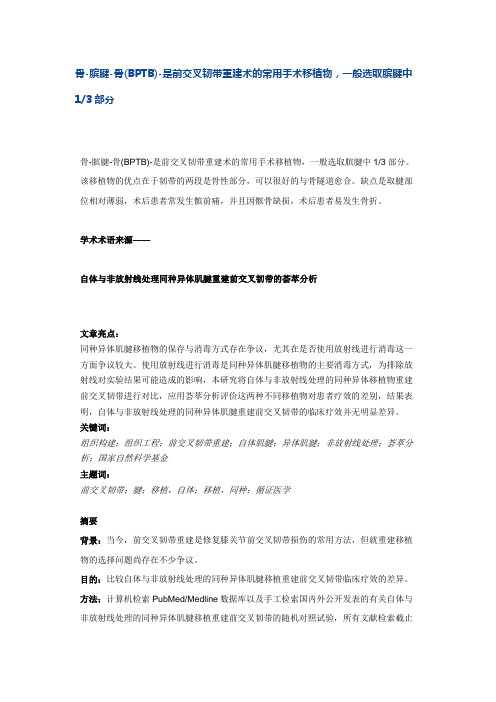
骨-膑腱-骨(BPTB)-是前交叉韧带重建术的常用手术移植物,一般选取膑腱中1/3部分骨-膑腱-骨(BPTB)-是前交叉韧带重建术的常用手术移植物,一般选取膑腱中1/3部分。
该移植物的优点在于韧带的两段是骨性部分,可以很好的与骨隧道愈合。
缺点是取腱部位相对薄弱,术后患者常发生髌前痛,并且因髌骨缺损,术后患者易发生骨折。
学术术语来源——自体与非放射线处理同种异体肌腱重建前交叉韧带的荟萃分析文章亮点:同种异体肌腱移植物的保存与消毒方式存在争议,尤其在是否使用放射线进行消毒这一方面争议较大。
使用放射线进行消毒是同种异体肌腱移植物的主要消毒方式,为排除放射线对实验结果可能造成的影响,本研究将自体与非放射线处理的同种异体移植物重建前交叉韧带进行对比,应用荟萃分析评价这两种不同移植物对患者疗效的差别,结果表明,自体与非放射线处理的同种异体肌腱重建前交叉韧带的临床疗效并无明显差异。
关键词:组织构建;组织工程;前交叉韧带重建;自体肌腱;异体肌腱;非放射线处理;荟萃分析;国家自然科学基金主题词:前交叉韧带;腱;移植,自体;移植,同种;循证医学摘要背景:当今,前交叉韧带重建是修复膝关节前交叉韧带损伤的常用方法,但就重建移植物的选择问题尚存在不少争议。
目的:比较自体与非放射线处理的同种异体肌腱移植重建前交叉韧带临床疗效的差异。
方法:计算机检索PubMed/Medline数据库以及手工检索国内外公开发表的有关自体与非放射线处理的同种异体肌腱移植重建前交叉韧带的随机对照试验,所有文献检索截止至2014年7月12日。
应用RevMan5.2软件进行数据统计分析,输入数据时采取双人核对以确保准确无误。
结果与结论:共纳入6项随机对照试验,累计858例受试对象,其中自体肌腱组441例,非放射线处理的同种异体肌腱组417例。
荟萃分析结果显示,自体与非放射性处理的同种异体肌腱移植重建前交叉韧带的总IKDC评分[相对危险度=1.02,95%置信区间(0.99-1.06),P=0.21];松弛度[均数差=-0.13,95%置信区间(-0.29至-0.02),P=0.09];Lachman试验[相对危险度=1.04,95%置信区间(0.95-1.13),P=0.37];pivot shift试验[相对危险度=1.00,95%置信区间(0.95-1.05),P=0.96];one-leg hop试验[相对危险度=1.01,95%置信区间(0.96-1.06),P=0.77];Lysholm评分[均数差=-0.64,95%置信区间(-1.45-0.17),P=0.12];Tegner评分[均数差=0.16,95%置信区间(-0.16-0.47),P=0.34]以及并发症发生率[相对危险度=1.42,95%置信区间(0.67-3.04),P=0.36]的差异无显著性意义。
前十字韧带重建中两种移植物的选择对临床效果的影响
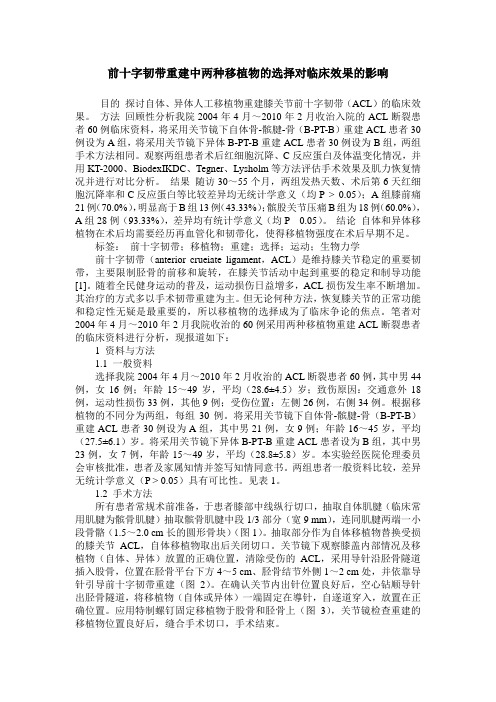
前十字韧带重建中两种移植物的选择对临床效果的影响目的探讨自体、异体人工移植物重建膝关节前十字韧带(ACL)的临床效果。
方法回顾性分析我院2004年4月~2010年2月收治入院的ACL断裂患者60例临床资料,将采用关节镜下自体骨-髌腱-骨(B-PT-B)重建ACL患者30例设为A组,将采用关节镜下异体B-PT-B重建ACL患者30例设为B组,两组手术方法相同。
观察两组患者术后红细胞沉降、C反应蛋白及体温变化情况,并用KT-2000、BiodexIKDC、Tegner、Lysholm等方法评估手术效果及肌力恢复情况并进行对比分析。
结果随访30~55个月,两组发热天数、术后第6天红细胞沉降率和C反应蛋白等比较差异均无统计学意义(均P > 0.05);A组膝前痛21例(70.0%),明显高于B组13例(43.33%);髌股关节压痛B组为18例(60.0%),A组28例(93.33%),差异均有统计学意义(均P 0.05)。
结论自体和异体移植物在术后均需要经历再血管化和韧带化,使得移植物强度在术后早期不足。
标签:前十字韧带;移植物;重建;选择;运动;生物力学前十字韧带(anterior crueiate ligament,ACL)是维持膝关节稳定的重要韧带,主要限制胫骨的前移和旋转,在膝关节活动中起到重要的稳定和制导功能[1]。
随着全民健身运动的普及,运动损伤日益增多,ACL损伤发生率不断增加。
其治疗的方式多以手术韧带重建为主。
但无论何种方法,恢复膝关节的正常功能和稳定性无疑是最重要的,所以移植物的选择成为了临床争论的焦点。
笔者对2004年4月~2010年2月我院收治的60例采用两种移植物重建ACL断裂患者的临床资料进行分析,现报道如下:1 资料与方法1.1 一般资料选择我院2004年4月~2010年2月收治的ACL断裂患者60例,其中男44例,女16例;年龄15~49岁,平均(28.6±4.5)岁;致伤原因:交通意外18例,运动性损伤33例,其他9例;受伤位置:左侧26例,右侧34例。
运动医学之-- 前交叉韧带重建术
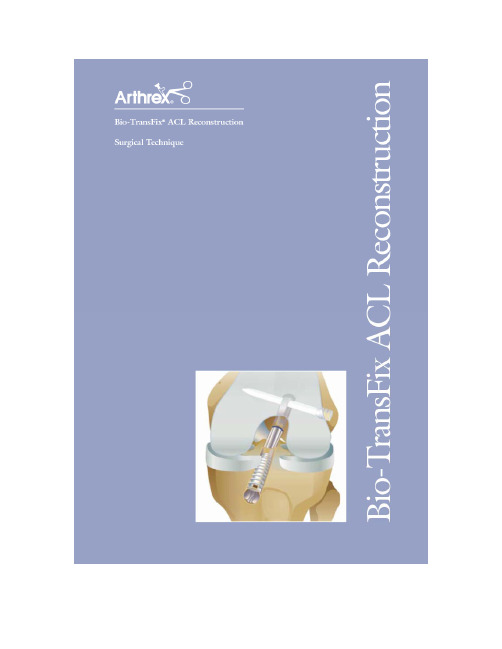
1.将半腱肌和骨薄肌的自体移植物固定于操作台上。
使肌腱绕过可调节柱,两端分别用钳具牢固固定。
如果需要,可在操作台上安装弹簧张力调节器,使肌腱预拉伸。
在肌腱的近端30mm处使用亚甲兰进行标记。
从标记处向远端30mm处使用#2 FiberWire缝线编织缝合肌腱。
编织完成后,测量肌腱移植物的直径。
一根完整的肌腱移植物长度应该控制在100--200mm。
aaBio-TransFix II ACL 重建系统器械 (AR-1817TS):TransFix II Implant Impactor on Handle AR-1973Bio-TransFix Driver AR-1973BD TransFix Screw Driver AR-1364Drill for TransFix Implant, 5 mm, for 3 mm Drill Pin AR-1974Drill for TransFix Implant, 5 mm, for 3 mm Drill Pin, long AR-1974L Drill Guide Assembly for TransFix II AR-1975 TransFix II Guide Pin Sleeve, 3 mm AR-1976 TransFix II Tunnel Hook, 7 mm AR-1977-07P TransFix II Tunnel Hook, 8 mm AR-1977-08P TransFix II Tunnel Hook, 9 mm AR-1977-09P TransFix II Tunnel Hook, 10 mm AR-1977-10P TransFix II Tunnel Hook, 11 mm AR-1977-11P TransFix II Tunnel Hook, 12 mm AR-1977-12P Semitendinosus Stripper, 5 mm AR-1278 TransFix II Instrumentation Case AR-1817TC Bio-TransFix Dilator AR-1373Bio-TransFix Extraction Pin AR-1973E Bio-TransFix 植入物:Bio-TransFix Implant, 5 mm x 40 mm AR-135IB Bio-TransFix Implant, 5 mm x 50 mm AR-135ILB TransFix II Pin & Graft Passing Wire Set AR-1978S Transtibial ACL Disposables Kit, w/o Saw Blade, box of 5 each AR-1898S Delta Screw 胫骨固定螺钉器械:ACL Tunnel Preparation Instrumentation Set (Dilators 7-10 mm diameter) AR-1856S Ratcheting Screwdriver Handle AR-1999 Cannulated Screwdriver Shaft for Delta Screws AR-1997D Torque Measurement Device AR-1990 Quad Notcher Set AR-1842S 胫骨固定螺钉:Delta Tapered Bio-Interference Screw, 7.5 mm - 9 mm x 35 mm AR-5035TB-09 Delta Tapered Bio-Interference Screw, 8.5 mm - 10 mm x 35 mm AR-5035TB-10 Delta Tapered Bio-Interference Screw, 9.5 mm - 11 mm x 35 mm AR-5035TB-11 Delta Tapered Bio-Interference Screw, 10.5 mm - 12 mm x 35 mm AR-5035TB-12 胫骨后援固定螺钉:Bio-Tenodesis Screw System Instrumentation Set AR-1675SBio-Tenodesis Disposable Kit AR-1675DS Bio-Tenodesis Screw, 4 mm x 10 mm AR-1540B Bio-Tenodesis Screw, 4.75 mm x 15 mm AR-1547B Tenodesis Screw, titanium, 4.75 mm x 15 mm AR-1350-475 Tenodesis Screw, titanium, 5.5 mm x 15 mm AR-1350-55 Bio-Tenodesis Screw, 5.5 mm (FiberWire fixation option) AR-1555B Bio-Tenodesis Screw, 6.25 mm x 15 mm AR-1562B Bio-Tenodesis Screw, 7 mm x 23 mm AR-1570B Bio-Tenodesis Screw, 8 mm x 23 mm AR-1580B Bio-Tenodesis Screw, 9 mm x 23 mm AR-1590B Bio-Tenodesis Screw, 7 mm x 10 mm AR-1670B Bio-Tenodesis Screw, 8 mm x 12 mm AR-1680B 股骨与胫骨隧道准备器械:ACL Cruciate Reconstruction ToolBox Set AR-1900S 取腱器械:Semitendinosus Stripper, closed end, 5 mm diameter AR-1278 Semitendinosus Stripper, closed end, 7 mm diameter AR-1278L Pigtail Hamstring Tendon Stripper, open end, 5 mm diameter AR-1278P 移植物准备器械:Graft Prep Station Basic Set for Soft Tissue Grafts AR-2950S#2 FiberWire, 38 inches (blue) w/Tapered Needles, 26.5 mm 1/2 circle, qty. 12 AR-7200所有植入物均已经消毒并且只能一次性使用。
韧带重建材料的选择
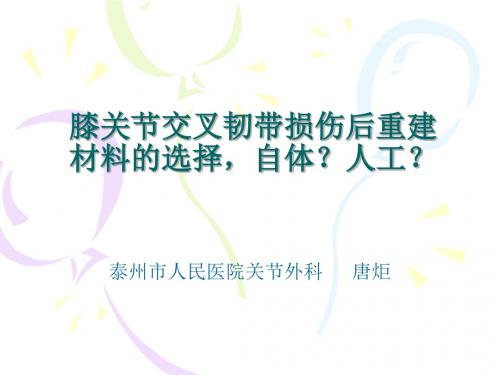
一致公认其为安全产品
LARS韧带的力学性能
唯一通过牵拉-扭转-屈曲实验的产品。 可以承受5000牛顿的拉力,是正常韧带2-3倍。 静态拉长试验:受力300、700、1700牛顿力 后24小时,拉长部分的长度小于1.5%,可忽 略不计。 日常生活前交叉韧带受力情况:上台阶67牛 顿,下台阶133牛顿,慢跑630牛顿。
LARS韧带的优点
1、不需自生取材 ,避免了取材部位并发症。 2、手术操作方便,手术时间短,创伤小。 3、术后可以早期功能锻炼,恢复快。
LARS韧带的缺点
1、手术需由操作娴熟的关节外科医生实施, 专业技术要求高。 2、人工韧带为进口内植物,价格昂贵,患者 多难以接受。 3、韧带作为人工植入物,其纤维在活动中存 在一定程度磨损率,使韧带存在一定使用寿 命,而相关数据尚缺乏远期随访报道。
经关节镜重建交叉韧带技术的引入
随着关节镜技术的日益发展和成熟,关节镜 下交叉韧带的重建已被广大临床医师和患者 所接受。其优势和临床疗效也是传统治疗手 段所无法比拟的。
交叉韧带重建材料的选择
自体肌腱——BTB(骨-腱-骨),强度高、刚度大、 骨-骨愈合好,而被公认为交叉韧带重建的“金标 准”。HT(腘绳肌腱),强度、刚度较大,对伸膝 装置无干扰,为大多数医生的首选。 异体肌腱——有良好的强度和刚度,手术创伤小, 无取材副损伤,但是存在排斥反应和传播传染性疾 病的风险。 LARS人工韧带——第四代人工韧带,临床应用才10 余年,远期效果有待观察。
Brown CH Jr,Steiner ME,Carson EW.The use of hamstring tendons for anterior cruciate ligament reconstruction.Technique and results[J].Clin Sports Med,1993,12(4):723-756.
前交叉韧带重建术后肌腱移植物成熟度的研究进展
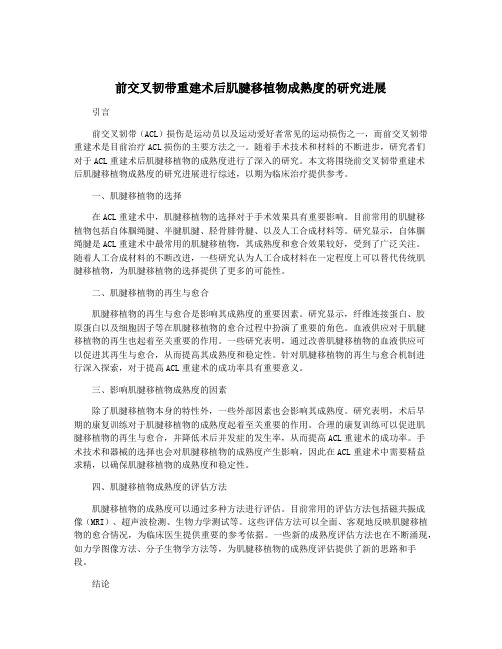
前交叉韧带重建术后肌腱移植物成熟度的研究进展引言前交叉韧带(ACL)损伤是运动员以及运动爱好者常见的运动损伤之一,而前交叉韧带重建术是目前治疗ACL损伤的主要方法之一。
随着手术技术和材料的不断进步,研究者们对于ACL重建术后肌腱移植物的成熟度进行了深入的研究。
本文将围绕前交叉韧带重建术后肌腱移植物成熟度的研究进展进行综述,以期为临床治疗提供参考。
一、肌腱移植物的选择在ACL重建术中,肌腱移植物的选择对于手术效果具有重要影响。
目前常用的肌腱移植物包括自体腘绳腱、半腱肌腱、胫骨腓骨腱、以及人工合成材料等。
研究显示,自体腘绳腱是ACL重建术中最常用的肌腱移植物,其成熟度和愈合效果较好,受到了广泛关注。
随着人工合成材料的不断改进,一些研究认为人工合成材料在一定程度上可以替代传统肌腱移植物,为肌腱移植物的选择提供了更多的可能性。
二、肌腱移植物的再生与愈合肌腱移植物的再生与愈合是影响其成熟度的重要因素。
研究显示,纤维连接蛋白、胶原蛋白以及细胞因子等在肌腱移植物的愈合过程中扮演了重要的角色。
血液供应对于肌腱移植物的再生也起着至关重要的作用。
一些研究表明,通过改善肌腱移植物的血液供应可以促进其再生与愈合,从而提高其成熟度和稳定性。
针对肌腱移植物的再生与愈合机制进行深入探索,对于提高ACL重建术的成功率具有重要意义。
三、影响肌腱移植物成熟度的因素除了肌腱移植物本身的特性外,一些外部因素也会影响其成熟度。
研究表明,术后早期的康复训练对于肌腱移植物的成熟度起着至关重要的作用。
合理的康复训练可以促进肌腱移植物的再生与愈合,并降低术后并发症的发生率,从而提高ACL重建术的成功率。
手术技术和器械的选择也会对肌腱移植物的成熟度产生影响,因此在ACL重建术中需要精益求精,以确保肌腱移植物的成熟度和稳定性。
四、肌腱移植物成熟度的评估方法肌腱移植物的成熟度可以通过多种方法进行评估。
目前常用的评估方法包括磁共振成像(MRI)、超声波检测、生物力学测试等。
交叉韧带重建移植物的选择38页PPT
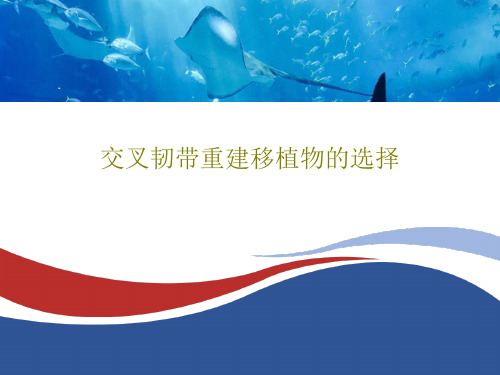
6、最大的骄傲于最大的自卑都表示心灵的最软弱无力。——斯宾诺莎 7、自知之明是最难得的知识。——西班牙 8、勇气通往天堂,怯懦通往地狱。——塞内加 9、有时候读书是一种巧妙地避开思考的方法。——赫尔普斯 10、阅读一切好书如同和过去最杰出的人谈话。——笛卡儿
交叉韧带重建移植物的选择
16、人民应该为法律而战斗,就像为 了城墙 而战斗 一样。 ——赫 拉克利 特 17、人类对于不公正的行为加以指责 ,并非 因为他 们愿意 做出这 种行为 ,而是 惟恐自 己会成 为这种 行为的 牺牲者 。—— 柏拉图 18、制定法律法令,就是为了不让强 者做什 么事都 横行霸 道。— —奥维 德 19、法律是社会的习惯和思想的结晶 。—— 托·伍·威尔逊 20、人们嘴上挂着的法律,其真实含 义是财 富。— —爱献 生
Thank yБайду номын сангаасu
前交叉韧带重建金属固定物说明
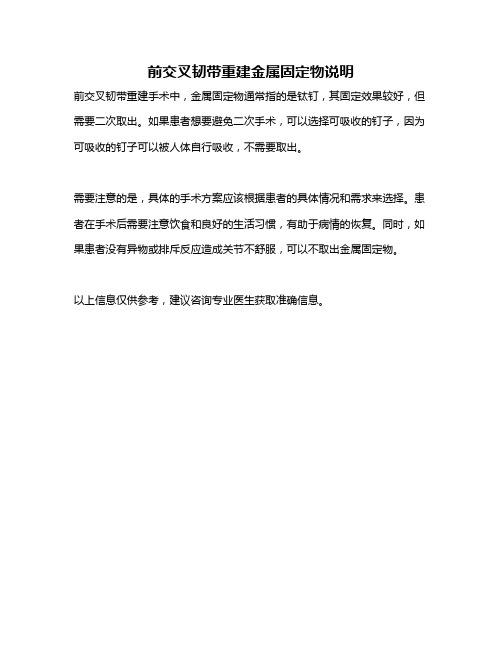
前交叉韧带重建金属固定物说明
前交叉韧带重建手术中,金属固定物通常指的是钛钉,其固定效果较好,但需要二次取出。
如果患者想要避免二次手术,可以选择可吸收的钉子,因为可吸收的钉子可以被人体自行吸收,不需要取出。
需要注意的是,具体的手术方案应该根据患者的具体情况和需求来选择。
患者在手术后需要注意饮食和良好的生活习惯,有助于病情的恢复。
同时,如果患者没有异物或排斥反应造成关节不舒服,可以不取出金属固定物。
以上信息仅供参考,建议咨询专业医生获取准确信息。
膝关节镜下采用两种自体材料重建前交叉韧带的临床效果对比
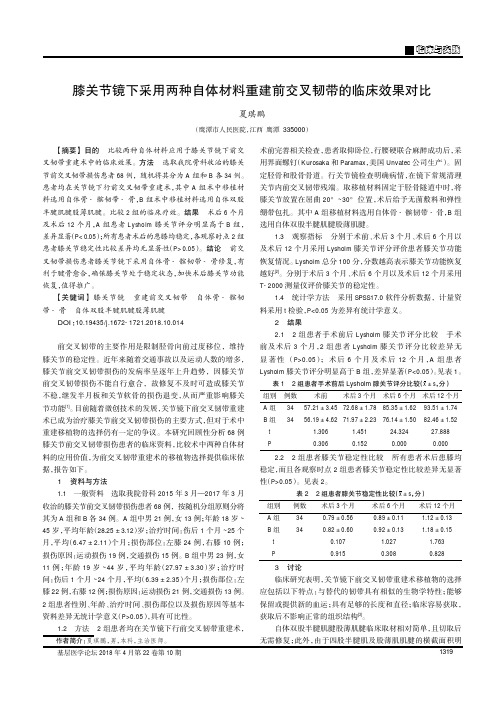
膝关节镜下采用两种自体材料重建前交叉韧带的临床效果对比夏琪鹏(鹰潭市人民医院,江西鹰潭335000)【摘要】目的比较两种自体材料应用于膝关节镜下前交叉韧带重建术中的临床效果。
方法选取我院骨科收治的膝关节前交叉韧带损伤患者68例,随机将其分为A组和B各34例。
患者均在关节镜下行前交叉韧带重建术,其中A组术中移植材料选用自体骨-髌韧带-骨,B组术中移植材料选用自体双股半腱肌腱股薄肌腱。
比较2组的临床疗效。
结果术后6个月及术后12个月,A组患者Lysholm膝关节评分明显高于B组,差异显著(P<0.05);所有患者术后的患膝均稳定,各观察时点2组患者膝关节稳定性比较差异均无显著性(P>0.05)。
结论前交叉韧带损伤患者膝关节镜下采用自体骨-髌韧带-骨修复,有利于腱骨愈合,确保膝关节处于稳定状态,加快术后膝关节功能恢复,值得推广。
【关键词】膝关节镜重建前交叉韧带自体骨-髌韧带-骨自体双股半腱肌腱股薄肌腱DOI:10.19435/j.1672-1721.2018.10.014前交叉韧带的主要作用是限制胫骨向前过度移位,维持膝关节的稳定性。
近年来随着交通事故以及运动人数的增多,膝关节前交叉韧带损伤的发病率呈逐年上升趋势,因膝关节前交叉韧带损伤不能自行愈合,故修复不及时可造成膝关节不稳,继发半月板和关节软骨的损伤退变,从而严重影响膝关节功能[1]。
目前随着微创技术的发展,关节镜下前交叉韧带重建术已成为治疗膝关节前交叉韧带损伤的主要方式,但对于术中重建移植物的选择仍有一定的争议。
本研究回顾性分析68例膝关节前交叉韧带损伤患者的临床资料,比较术中两种自体材料的应用价值,为前交叉韧带重建术的移植物选择提供临床依据,报告如下。
1资料与方法1.1一般资料选取我院骨科2015年3月—2017年3月收治的膝关节前交叉韧带损伤患者68例,按随机分组原则分将其为A组和B各34例。
A组中男21例,女13例;年龄18岁~ 45岁,平均年龄(28.25±3.12)岁;治疗时间:伤后1个月~25个月,平均(6.47±2.11)个月;损伤部位:左膝24例,右膝10例;损伤原因:运动损伤19例,交通损伤15例。
- 1、下载文档前请自行甄别文档内容的完整性,平台不提供额外的编辑、内容补充、找答案等附加服务。
- 2、"仅部分预览"的文档,不可在线预览部分如存在完整性等问题,可反馈申请退款(可完整预览的文档不适用该条件!)。
- 3、如文档侵犯您的权益,请联系客服反馈,我们会尽快为您处理(人工客服工作时间:9:00-18:30)。
本人水平有限,翻译不准之处,望各位指正,大家共同进步~Graft Selection for Anterior Cruciate Ligament Reconstruction:A Level I Systematic Review Comparing Failure Rates and Functional Outcomes前交叉韧带重建的移植物选择:一篇将失败率与功能性结局指标同时比较的Ⅰ级循证系统综述KEYWORDSAnterior cruciate ligament Bone-patellar tendon-bone composites Combined semitendinosus and gracilis hamstring tendons Revision关键词:前交叉韧带骨-髌韧带-骨移植物联合应用半腱肌和股四头肌腘绳肌腱翻修Tear of the anterior cruciate ligament (ACL) is the most common ligamentous injury of the knee. Reconstructing this ligament is often required to restore functional stability of the knee.1,2 Despite the popularity of the procedure, the preferred graft remains controversial. Ideally, the graft should have similar characteristics as the native ACL. Regardless of graft type, the biologic and mechanical properties of the graft material should provide a favorable setting for early biologic incorporation, be amenable to secure fixation, and limit potential morbidity related to donor site.前交叉韧带(ACL)撕裂是最常见的膝关节韧带损伤。
韧带重建的目的就是要恢复膝关节的功能性稳定。
尽管(重建)过程各异,但移植物的选择仍有争议。
理想的移植物应该与天然ACL具有相似的特性。
尽管移植物类型各异,但其生物学及力学特性都应该为(重建后的)早期生物学整合提供有利环境,有利于安全固定,并限制供体部位潜在的发病率。
Many graft options are available for ACL reconstruction, including different autograft and allograft tissues. Autografts include bone-patellar tendon-bone composites (PT), combined semitendinosus and gracilis hamstring tendons (HT), and quadriceps tendon. Allograft options include the same types of tendonsharvested from donors, in addition to Achilles and tibialis tendons. Tissue-engineered anterior cruciate grafts are not yet available for clinical use, but may become a feasible alternative in the future.ACL重建有多种移植物可供选择,包括自体组织移植物和异体组织移植物。
自体移植物包括骨-髌韧带-骨移植物(PT)、联合应用半腱肌骨薄肌腘绳肌腱(HT)和股四头肌腱。
除了跟腱和胫骨肌腱之外,还包括取自供者的相同类型的肌腱。
组织工程生产的ACL尚未用于临床,但其将来可能成为一种可行的ACL替代物。
For the past few decades, PT autograft has been the gold standard for ACL reconstruction. Reasons for this include the strength of the tissue, relative ease of harvest, and bone-to-bone healing with secure fixation. More recently, HT autografts have joined PT in surgeons‘ popularity.3 The recent trend toward increased use of HT resulted from concerns with use of PT relating to a potential negative effect on the knee extensor mechanism and donor site morbidity, including anterior knee pain and risk for patella fracture.4 Nevertheless, despite their increasing popularity, HT grafts also have potential limitations, including slower soft tissue graft-tunnel healing compared with bone-to-bone healing with PT grafts, potential for tunnel widening and graft laxity, and functional hamstring weakness resulting from graft harvesting.5,6在过去的几十年中,PT已经成为ACL重建(移植物选择)的金标准。
原因包括其组织强度、(移植物)较易获得和安全固定的骨骨愈合(程度)。
近来,HT移植物已越来越受到外科医生的欢迎。
鉴于PT可能对膝关节伸肌有潜在的消极影响和提高供体部位病变率(包括膝关节前疼痛和髌骨骨折),HT的应用有逐渐升高的趋势。
然而,尽管越来越受欢迎,但HT也有其潜在的限制,包括与PT的骨骨愈合相比的减慢的软组织移植物隧道愈合(速度),潜在的骨隧道扩大和移植物松弛,以及由移植物采集引起的功能性股薄肌无力。
There are several randomized controlled trials (RCTs) in the literature comparing the two most popular graft choices, PT and HT, either used as autografts or allografts. Many of the systematic reviews and meta-analyses in the literature that investigate graft choice for ACL reconstruction are biased by their inclusion of inadequately randomized trials that are not true level I studies.7–9 Also, functional outcomes,rather than graft failure, tend to be the focus of these reviews. The authors believe, however, that graft failure represents a critically important outcome measure in ACL reconstruction, which has not been given enough attention in previous systematic reviews and meta-analyses. The purpose of this systematic review is to assess whether one of the popular grafts (PT and HT) is preferable for reconstructing the ACL. For this objective the authors selected only true level I studies that compared these graft choices in functional clinical outcomes, failure rates, and other objective parameters following reconstruction of the ACL.无论是作为自体移植物还是异体移植物,对于PT和HT的选择,已有数篇随机对照试验(RCT)对其进行比较。
许多研究ACL重建移植物选择的系统综述和meta分析因为不完善的随机试验而造成偏倚,而不能称为真正的Ⅰ级循证研究。
而且,这些综述往往关注于功能性结局指标而非移植失败率。
作者认为,作为一项非常重要的ACL重建结局评价指标,移植失败率并没有在以往的系统综述和meta分析中得到足够的重视。
本综述的目的就是评估哪一种移植物(PT或HT)更适合于ACL重建。
因此,作者选择了将功能性结局指标、失败率和其他客观参数进行比较的真正的Ⅰ级循证研究。
METHODSA systematic literature review was performed using the following data sources: MEDLINE with OVID and PubMed (basic search, related articles, clinical queries search), EMBASE, and the Cochrane Central Register of Controlled Trials for relevant articles in the English language. Bibliographies of the identified articles on this topic were also reviewed. In addition, a manual search of recent pertinent hard copy journals from the previous 6 months was undertaken to identify journal articles that may not yet have been included in electronic databases.方法本系统综述的相关英文文献是从以下数据库:基于OVID 和PubMed平台的MEDLINE(基本检索、相关文献、临床疑问检索)、EMBASE和Cochrane随机对照试验注册中心。
